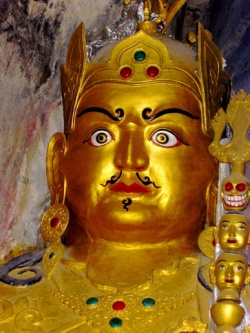Dharma classifications to āyatana and dhātu
12 Āyatana, 12 bases of consciousness
In my previous post I described the division of dharmas from the psychological viewpoint into 5 aggregates (skandha), but a more detailed classification of 75 dharmas is division to cognitive abilities and their objects. According to it there are 6 sources of knowledge and 6 categories of objects correspond to them, commonly known as 12 āyatana or 12 gates of consciousness. The sources of knowledge represent themselves elements that are the cause for a consciousness to manifest itself. Those sources of knowledge are:
| 6 Faculties or organs of perception: | 6 external gates or objects: |
| 1. Eye (Caksur) | 1. Visible (form and colour)(Rupa) |
| 2. Ear (Srotra) | 2. Sound (Sabda) |
| 3. Nose (Ghrana) | 3.Smell (Gandha) |
| 4. Tongue (Jihva) | 4. Taste (Rasa) |
| 5. Touch (Kaya) | 5. Tangible (Sparstavya) |
| 6. Mind (Mano) | 6. Insensible objects (dharma-āyatana) |
he first 11 sections in this classification correspond to 11 elements (dharma), i.e. each section is represented by one element. The twelfth section contains all the 64 remaining elements. “Āyatana” means “Entrance” (or “doors”); here it is “entrance” for a consciousness and psychic elements. Consciousness never arise by itself, by itself it would be pure and without any content and we hardly would call it a consciousness. It is always supported by 2 elements: the source of knowledge (sensation) and its corresponding object. Consciousness has 2 “doors” to manifest itself. For example, the consciousness or awareness of sight originates from connecting the organ of sight with something visible. In case of the 6th source of knowledge the consciousness itself, i.e. the former moment of it, act as an object of mental constructions.
Dharma classification to 12 āyatana represents a division of all sources of knowledge into sensible and insensible objects. The Sensible are divided to 10 groups according to 5 organs of senses and 5 objects of senses, but all insensible elements are not separated. In this way 12 āyatana or “bases of consciousness” includes all 75 elements of existence divided into 6 subjective and 6 corresponding objective divisions.
Dharmas classified to 18 Dhātu (elements)
Division of dharma-elements to 18 classes of elements or dhātu is kind of similar with the division into bases (āyatana). In its first 12 chapters it repeats the division to āyatana. However, it is based upon a different angle. According to the tradition it is intended for those who consider all sensible and psychic elements together as “I”. Philosophy of Buddhism analyses separate elements or forces that combines together creating a flow of events. Superficial mind of ordinary people consider that flow is a personality or an individual. If we observe dharma-elements as components of such a flow, they are called dhātu. This flow consists of 6 senses, 6 kinds of objective elements and 6 kinds of consciousness, starting with Visual Consciousness and ending with Mental Consciousness or Consciousness of Insensible. In this way additionally to 12 components that are 12 Bases of Consciousness we are getting:
| 6 Consciousnesses | 6 Faculties or organs of perception: | 6 external gates or objects: |
| 1.Visual Consciousness |
1. Eye (Caksur) | 1. Visible (form and colour) (Rupa) |
| 2. Aural Consciousness |
2. Ear (Srotra) | 2. Sound (Sabda) |
| 3. Olfactory Consciousness |
3. Nose (Ghrana) | 3.Smell (Gandha) |
| 4. Gustatory Consciousness |
4. Tongue (Jihva) | 4. Taste (Rasa) |
| 5. Touch Consciousness |
5. Touch (Kaya) | 5.Tangible (Sparstavya) |
| 6. Mental Consciousness |
6. Mind (Mano) | 6. Insensible objects |
Consciousness, which is generally a single element, is separated into 7 parts here, as it enters the flow of individual life as ability and 6 different kinds of senses that differentiate depending on their source of origination – from a single organ of senses or from insensible.
That number of types of consciousness exists only on the ordinary level of existence. In the worlds of meditative concentration, in worlds of Forms and No-Forms the consciousnesses of senses gradually disappear. In non-material worlds only consciousness of insensible objects remains.
The division of consciousness into multiple types (dhātu 13-18) is necessary to create a scheme of dharma-elements that corresponds to beings from different worlds. And it is worth to know, all those worlds exist in parallel right here on the earth. In other words, it is a view of world with the eyes of humans at different levels of psychological development.



